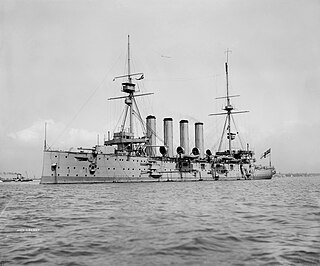Four ships of the Royal Navy have borne the name HMS Cressy, after the Battle of Crécy.

The Royal Navy (RN) is the United Kingdom's naval warfare force. Although warships were used by the English kings from the early medieval period, the first major maritime engagements were fought in the Hundred Years War against the Kingdom of France. The modern Royal Navy traces its origins to the early 16th century; the oldest of the UK's armed services, it is known as the Senior Service.

The Battle of Crécy, also spelled Cressy, was an English victory during the Edwardian phase part of the Chevauchée of Edward III of 1346 during the Hundred Years' War. It was the first of three famous English successes during the conflict, followed by Poitiers in 1356 and Agincourt in 1415.
- HMS Cressy (1810) was a 74-gun third rate launched in 1810 and broken up in 1832.
- HMS Cressy (1853) was an 80-gun screw propelled third rate launched in 1853 and sold in 1867.
- HMS Cressy (1899) was a Cressy-class armoured cruiser launched in 1899 and sunk by a U-boat in 1914.
- HMS Cressy was the name given to the 46-gun fifth rate HMS Unicorn between 1941 and 1959 while she was serving as a drill ship for the Royal Naval Reserve. She was handed over for preservation in 1968.
HMS Cressy was a 74-gun third rate ship of the line of the Royal Navy, launched on 7 March 1810 at Frindsbury.

HMS Cressy was a Cressy-class armoured cruiser built for the Royal Navy around 1900. Upon completion she was assigned to the China Station. In 1907 she was transferred to the North America and West Indies Station before being placed in reserve in 1909. Recommissioned at the start of World War I, she played a minor role in the Battle of Heligoland Bight a few weeks after the beginning of the war. Cressy, together with two of her sister ships, was torpedoed and sunk by the German submarine U-9 on 22 September 1914 with the loss of 560 of her crew.

The Cressy-class cruiser was a class of six armoured cruisers built for the Royal Navy around 1900. Their design's incorporation of a pair of 9.2-inch guns and armoured sides served to address criticism directed against the previous Diadem class — advances made possible by their 1,000 ton increase in displacement over their predecessors. The ships were notably stable, except for a susceptibility to pitching.
| This article includes a list of ships with the same or similar names. If an internal link for a specific ship led you here, you may wish to change the link to point directly to the intended ship article, if one exists. |
